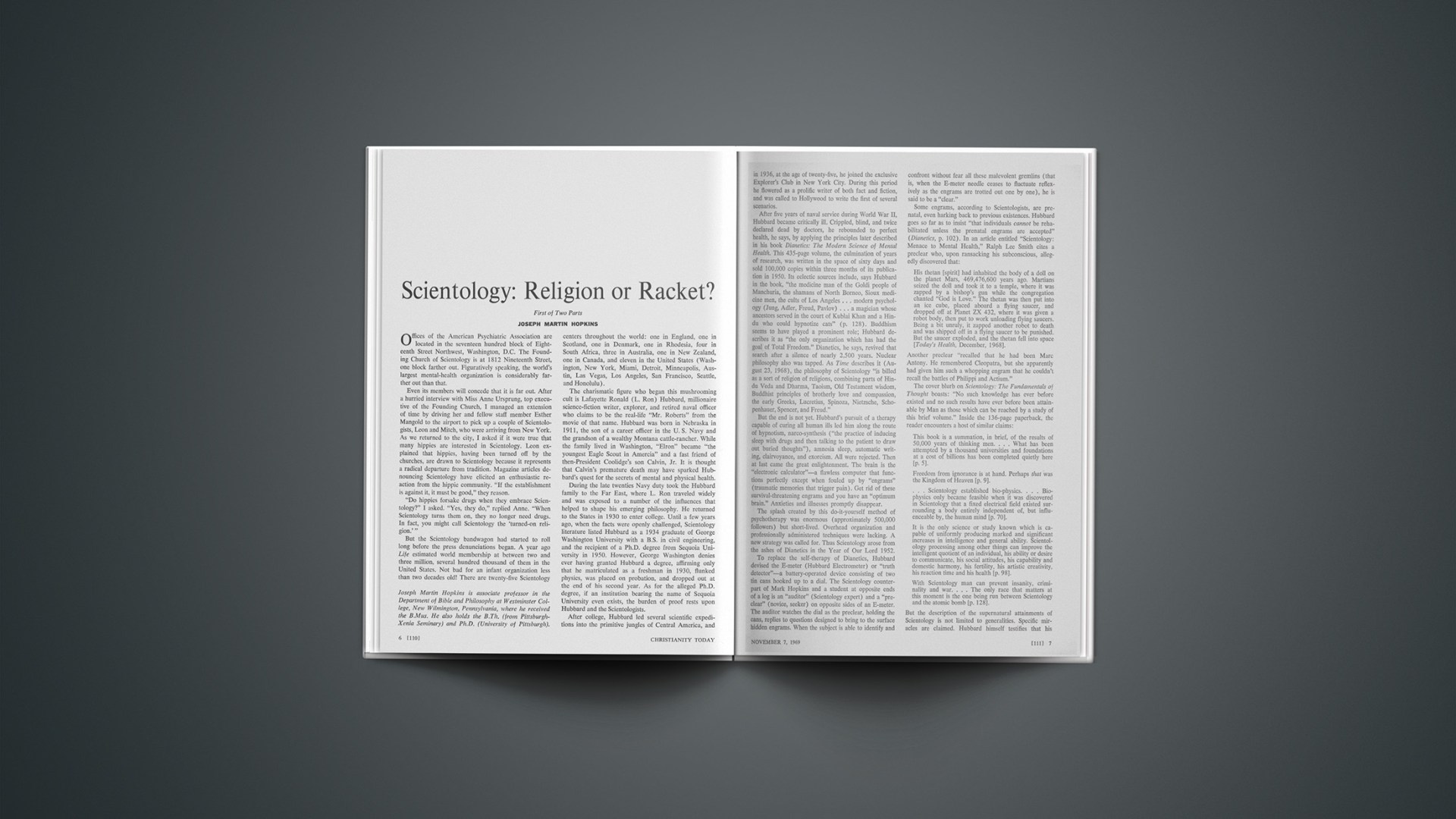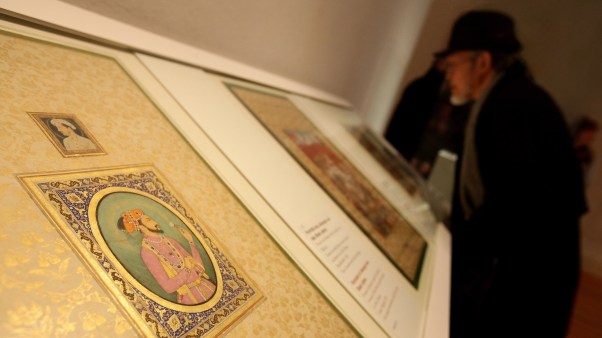Offices of the American Psychiatric Association are located in the seventeen hundred block of Eighteenth Street Northwest, Washington, D.C. The Founding Church of Scientology is at 1812 Nineteenth Street, one block farther out. Figuratively speaking, the world’s largest mental-health organization is considerably farther out than that.
Even its members will concede that it is far out. After a hurried interview with Miss Anne Ursprung, top executive of the Founding Church, I managed an extension of time by driving her and fellow staff member Esther Mangold to the airport to pick up a couple of Scientologists, Leon and Mitch, who were arriving from New York. As we returned to the city, I asked if it were true that many hippies are interested in Scientology. Leon explained that hippies, having been turned off by the churches, are drawn to Scientology because it represents a radical departure from tradition. Magazine articles denouncing Scientology have elicited an enthusiastic reaction from the hippie community. “If the establishment is against it, it must be good,” they reason.
“Do hippies forsake drugs when they embrace Scientology?” I asked. “Yes, they do,” replied Anne. “When Scientology turns them on, they no longer need drugs. In fact, you might call Scientology the ‘turned-on religion.’ ”
But the Scientology bandwagon had started to roll long before the press denunciations began. A year ago Life estimated world membership at between two and three million, several hundred thousand of them in the United States. Not bad for an infant organization less than two decades old! There are twenty-five Scientology centers throughout the world: one in England, one in Scotland, one in Denmark, one in Rhodesia, four in South Africa, three in Australia, one in New Zealand, one in Canada, and eleven in the United States (Washington, New York, Miami, Detroit, Minneapolis, Austin, Las Vegas, Los Angeles, San Francisco, Seattle, and Honolulu).
The charismatic figure who began this mushrooming cult is Lafayette Ronald (L. Ron) Hubbard, millionaire science-fiction writer, explorer, and retired naval officer who claims to be the real-life “Mr. Roberts” from the movie of that name. Hubbard was born in Nebraska in 1911, the son of a career officer in the U. S. Navy and the grandson of a wealthy Montana cattle-rancher. While the family lived in Washington, “Elron” became “the youngest Eagle Scout in Amercia” and a fast friend of then-President Coolidge’s son Calvin, Jr. It is thought that Calvin’s premature death may have sparked Hubbard’s quest for the secrets of mental and physical health.
During the late twenties Navy duty took the Hubbard family to the Far East, where L. Ron traveled widely and was exposed to a number of the influences that helped to shape his emerging philosophy. He returned to the States in 1930 to enter college. Until a few years ago, when the facts were openly challenged, Scientology literature listed Hubbard as a 1934 graduate of George Washington University with a B.S. in civil engineering, and the recipient of a Ph.D. degree from Sequoia University in 1950. However, George Washington denies ever having granted Hubbard a degree, affirming only that he matriculated as a freshman in 1930, flunked physics, was placed on probation, and dropped out at the end of his second year. As for the alleged Ph.D. degree, if an institution bearing the name of Sequoia University even exists, the burden of proof rests upon Hubbard and the Scientologists.
After college, Hubbard led several scientific expeditions into the primitive jungles of Central America, and in 1936, at the age of twenty-five, he joined the exclusive Explorer’s Club in New York City. During this period he flowered as a prolific writer of both fact and fiction, and was called to Hollywood to write the first of several scenarios.
After five years of naval service during World War II, Hubbard became critically ill. Crippled, blind, and twice declared dead by doctors, he rebounded to perfect health, he says, by applying the principles later described in his book Dianetics: The Modern Science of Mental Health. This 435-page volume, the culmination of years of research, was written in the space of sixty days and sold 100,000 copies within three months of its publication in 1950. Its eclectic sources include, says Hubbard in the book, “the medicine man of the Goldi people of Manchuria, the shamans of North Borneo, Sioux medicine men, the cults of Los Angeles … modern psychology (Jung, Adler, Freud, Pavlov) … a magician whose ancestors served in the court of Kublai Khan and a Hindu who could hypnotize cats” (p. 128). Buddhism seems to have played a prominent role; Hubbard describes it as “the only organization which has had the goal of Total Freedom.” Dianetics, he says, revived that search after a silence of nearly 2,500 years. Nuclear philosophy also was tapped. As Time describes it (August 23, 1968), the philosophy of Scientology “is billed as a sort of religion of religions, combining parts of Hindu Veda and Dharma, Taoism, Old Testament wisdom, Buddhist principles of brotherly love and compassion, the early Greeks, Lucretius, Spinoza, Nietzsche, Schopenhauer, Spencer, and Freud.”
But the end is not yet. Hubbard’s pursuit of a therapy capable of curing all human ills led him along the route of hypnotism, narco-synthesis (“the practice of inducing sleep with drugs and then talking to the patient to draw out buried thoughts”), amnesia sleep, automatic writing, clairvoyance, and exorcism. All were rejected. Then at last came the great enlightenment. The brain is the “electronic calculator”—a flawless computer that functions perfectly except when fouled up by “engrams” (traumatic memories that trigger pain). Get rid of these survival-threatening engrams and you have an “optimum brain.” Anxieties and illnesses promptly disappear.
The splash created by this do-it-yourself method of psychotherapy was enormous (approximately 500,000 followers) but short-lived. Overhead organization and professionally administered techniques were lacking. A new strategy was called for. Thus Scientology arose from the ashes of Dianetics in the Year of Our Lord 1952.
To replace the self-therapy of Dianetics, Hubbard devised the E-meter (Hubbard Electrometer) or “truth detector”—a battery-operated device consisting of two tin cans hooked up to a dial. The Scientology counterpart of Mark Hopkins and a student at opposite ends of a log is an “auditor” (Scientology expert) and a “preclear” (novice, seeker) on opposite sides of an E-meter. The auditor watches the dial as the preclear, holding the cans, replies to questions designed to bring to the surface hidden engrams. When the subject is able to identify and confront without fear all these malevolent gremlins (that is, when the E-meter needle ceases to fluctuate reflexively as the engrams are trotted out one by one), he is said to be a “clear.”
Some engrams, according to Scientologists, are prenatal, even harking back to previous existences. Hubbard goes so far as to insist “that individuals cannot be rehabilitated unless the prenatal engrams are accepted” (Dianetics, p. 102). In an article entitled “Scientology: Menace to Mental Health,” Ralph Lee Smith cites a preclear who, upon ransacking his subconscious, allegedly discovered that:
His thetan [spirit] had inhabited the body of a doll on the planet Mars, 469,476,600 years ago. Martians seized the doll and took it to a temple, where it was zapped by a bishop’s gun while the congregation chanted “God is Love.” The thetan was then put into an ice cube, placed aboard a flying saucer, and dropped off at Planet ZX 432, where it was given a robot body, then put to work unloading flying saucers. Being a bit unruly, it zapped another robot to death and was shipped off in a flying saucer to be punished. But the saucer exploded, and the thetan fell into space [Today’s Health, December, 1968].
Another preclear “recalled that he had been Marc Antony. He remembered Cleopatra, but she apparently had given him such a whopping engram that he couldn’t recall the battles of Philippi and Actium.”
The cover blurb on Scientology: The Fundamentals of Thought boasts: “No such knowledge has ever before existed and no such results have ever before been attainable by Man as those which can be reached by a study of this brief volume.” Inside the 136-page paperback, the reader encounters a host of similar claims:
This book is a summation, in brief, of the results of 50,000 years of thinking men.… What has been attempted by a thousand universities and foundations at a cost of billions has been completed quietly here [p. 5].
Freedom from ignorance is at hand. Perhaps that was the Kingdom of Heaven [p. 9].
… Scientology established bio-physics.… Biophysics only became feasible when it was discovered in Scientology that a fixed electrical field existed surrounding a body entirely independent of, but influenceable by, the human mind [p. 70].
It is the only science or study known which is capable of uniformly producing marked and significant increases in intelligence and general ability. Scientolology processing among other things can improve the intelligent quotient of an individual, his ability or desire to communicate, his social attitudes, his capability and domestic harmony, his fertility, his artistic creativity, his reaction time and his health [p. 98].
With Scientology man can prevent insanity, criminality and war.… The only race that matters at this moment is the one being run between Scientology and the atomic bomb [p. 128].
But the description of the supernatural attainments of Scientology is not limited to generalities. Specific miracles are claimed. Hubbard himself testifies that his thetan has visited Venus once and Heaven twice. (Incidentally, the second of his three wives testified that he was “hopelessly insane.”) “Tens of thousands of case histories” record miraculous healings of mind and body through Scientology techniques. The claim is made that through the creation of “mental energy,” up to thirty pounds have been added to or subtracted from a person’s body weight. Furthermore, Scientology can “raise the intelligence quotient of a person about one point per hour of processing” (A Brief Biography of L. Ron Hubbard, p. 10). At that astounding rate, the cost of producing an Einstein, at $30 per processing hour, would be relatively small. And to think that the ability to accomplish these miracles can be attained in a period of weeks and for only a few hundred dollars!
It is a curious thing that a great many intelligent, well educated, and apparently well balanced people have flocked to this movement. Take Anne Ursprung, for example. Reared in Texas, she was active in Southern Baptist youth work and at one time wanted to become a Christian-education director. At Baylor University she majored in English and history, and after her graduation she accepted a job as an English teacher in the District of Columbia. Her active involvement in Scientology began in November, 1967, when she began teaching evening classes at the Founding Church while continuing her daytime job in the Washington public-school system. The following February she became a full-time employee of the church, and in July she was elevated to the position of “assistant guardian,” the local congregation’s highest administrative office. Modest, poised, elegant in dress and manner, Miss Ursprung could easily pass for the Christian-education worker she once hoped to become.
Esther Mangold, another full-time employee of the Founding Church, is a graduate of the Westminster Choir College and once served as minister of music in a large mainline church in the Midwest.
Just recently, in response to punitive measures by the British Parliament, the organization published a pamphlet entitled A Report to Members of Parliament on Scientology. The booklet contains testimonies by an impressive list of Scientologists, among them a dental surgeon, two medical doctors, a former chemistry professor now devoting his life to Scientology, a Ph.D. professor of languages, and a mechanical engineer. All laud Scientology as the panacea for all ills, individual and social.
According to Miss Ursprung, the Scientology ranks have been swelled by a considerable number of Protestant clergymen. Perhaps the best explanation for this incongruity is that most people consider Scientology not a religion but a school of psychotherapy, despite Scientology claims to the contrary. Although Miss Ursprung classified Dianetics, forerunner of Scientology, as a “science of mind,” she insists that Scientology is “a religion, a religious philosophy, a way of life.” The distinction is based on Scientology’s “eight dynamics.” The first four, which come under the purview of Dianetics, are the survival instincts of (1) self, (2) sex and family, (3) group (school, society, town, nation), and (4) mankind (all races and nations). The last four relate to man as a spiritual being: (5) the animal dynamic (the urge to preserve animal and vegetable life), (6) the MEST (matter, energy, space, time) dynamic (the urge to preserve the physical universe), (7) the spiritual dynamic (the urge to perpetuate spiritual existence in the here and now), and (8) the Infinity or God dynamic (the instinct relating to immortal existence beyond the earthly life). Oddly enough, the one area most directly involving religious experience is ruled out of bounds. Hubbard emphasizes, “It is carefully observed here that the science of Scientology does not intrude into the Dynamic of the Supreme Being” (Scientology, pp. 39, 40).
By what stretch of the imagination, then, can Scientology be classified as a religion? Miss Ursprung’s answer is that a man’s relation with the Supreme Being is an individual matter. Self-understanding is the primary goal of Scientology. A man cannot know his Maker until he first of all knows himself. But, she insists, reverential attitudes are definitely encouraged in the movement. She quoted from Hubbard’s 1951 volume, Science of Survival: “No culture in the history of the world, save the thoroughly depraved and expiring one, has failed to affirm the existence of a Supreme Being. It is an empirical observation that men without a strong and lasting faith in a Supreme Being are less capable, less ethical, and less valuable to themselves and society.”
I was still puzzled. How could an organization erected on a theistic foundation, calling itself a church, be utterly divorced from prayer, worship, the Scriptures, and the sacraments? In the booklet Ceremonies of the Founding Church of Scientology are found marriage, christening, and funeral liturgies, not one of which includes a single prayer or reference to the Deity. This “informal christening” service, actually performed by L. Ron Hubbard and recommended as a guide, illustrates these omissions:
O.K. The parents of these children will bring them front and centre. (Speaking to the child): This is Mr. —— and this is Mrs. —— I’m introducing to the audience right now. And—— and—— have decided to be godfather and godmother, so we’re all set.
Here we go. (To the child): How are you? All right. Now your name is——. You got that? Good. There you are. Did that upset you? Now, do you realize that you’re a member of the HASI (Hubbard Association of Scientologists, International)? Pretty good, huh?
All right. Now I want to introduce you to your father. This is Mr.——. (To the parent): Come over here. (To the child): And here’s your mother.
And now, in case you get into trouble and want to borrow some quarters here’s Mr.——. See him? He’s your godfather. Now, take a look at him. That’s right.
And here’s——, in case you want some real good auditing; she’s your godmother. Got it?
Now you are suitably christened. Don’t worry about it, it could be worse. O.K. Thank you very much. They’ll treat you all right.
In a Scientology church service, the booklet explains, “we do not use prayers, attitudes of piety, or threats of damnation. We use the facts, the truths, the understandings that have been discovered in the science of Scientology. We do not read from the Bible (or the Koran or the Torah or the Vedic Hymns, for that matter) and say to the people … ‘Now this is something you have got to believe.’ ” Music selected for the service is to be “pleasant to listen to and not strongly associated with the wrath of the gods or helpless dependence on the whim of an unknown being.” The sermon “is ALWAYS on some phase of Scientology and how it can be of use to those present.” A taped lecture by L. Ron Hubbard is suggested as appropriate for this purpose.
In the December, 1968, issue of the New Zealand Methodist there appeared a discussion between Sir James Hort, a minister in the Church of Scientology, and three Protestant clergymen. The following excerpt is instructive:
Hort: The eighth dynamic is not inquired into. It is left to individual people to understand for themselves in time.
Ramage [the Reverend I.C.E.]: Before you reach the eighth dynamic, you wouldn’t feel that God has any part in your progress through the other stages?
Hort: I think the answer is no. This is somewhere where the Christian religion and ours would differ.
In an earlier comment, Hort had observed (regarding Scientology church services), “If an atheist or agnostic comes into Scientology, then our service is there for him.”
Joseph Martin Hopkins is associate professor in the Department of Bible nd Philosophy at Westminster College, New Wilmington Pennsylvania, where h recieved the B.Mus. He also holds he B.Th. (from Pittsburgh Xenia Seminary) and Ph.D. (University of Pittsburg).










